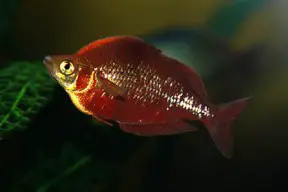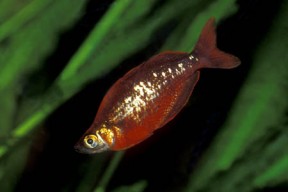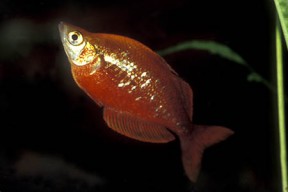Glossolepis incisus
Red Rainbowfish
Classification
Melanotaeniidae
Distribution
Indonesia, specifically the Lake Sentani region of Northern New Guinea. It’s usually found in shoals around heavily vegetated areas. The lake is connected to the ocean by a small tributary and so contains an interesting mix of species.
Habitat
The lake itself and surrounding waters.
Maximum Standard Length
6″ (15cm)
Aquarium SizeTop ↑
An active swimmer, so the tank should be at least 48″ x 12″ x 12″ (120cm x 30cm x 30cm) – 110 litres.
Maintenance
This species, like most rainbows, looks most at home in a planted aquarium. Provide areas of dense vegetation, along with some open areas for swimming. Water movement should be quite gentle.
Water Conditions
Temperature: 72-77°F (22-25°C)
pH: 7.0-8.0. It will not do well in soft, acidic conditions.
Hardness: 10-20°H
Diet
Unfussy and will accept most dried, frozen and live foods. Regular feedings of the latter two will ensure the best colouration.
Behaviour and CompatibilityTop ↑
Very peaceful but can disturb smaller or slow-moving fish with its rapid movements and relatively large size. Good tankmates include other similarly-sized rainbowfish, characins, danios, barbs, and catfish such as Corydoras.
The red rainbowfish is quite skittish and does far better when kept in a shoal of at least 6-8 fish, preferably more. The males will also be encouraged to display their best colours in the company of conspecifics. Obviously a suitably-sized aquarium would be required for a very large group.
Sexual Dimorphism
Mature males develop a much higher back than females as they grow. Also males are the only sex to develop the characteristic red colouration that gives this fish its common name. Interestingly, when kept at slightly lower temperature all males turn a red colour, whilst in warmer water only the dominant fish tend to do so.
Reproduction
Quite easy. Egg scatterer. The breeding aquarium should be at least 30″ long and contain slightly hard, alkaline water with a pH of around 7.5 and a temperature of 70-75°F. A small air-powered filter will provide sufficient oxygenation and flow. The tank should be filled with fine-leaved plants such as java moss, or nylon spawning mops. No substrate is necessary.
The adult fish are best conditioned in a group in a separate aquarium with plenty of live and frozen foods. Select the fattest pair for spawning and introduce them to the spawning tank. A small raise in temperature can induce spawning.
The pair will spawn for a period of several weeks, laying a few eggs each day. These are attached to surfaces by a small thread. Although the adults tend not to eat the spawn, it’s easier to raise the fry in a separate aquarium, so we recommend checking the plants or mops daily and removing any eggs you find to a raising tank containing water from the spawning tank.
The eggs hatch in 7-8 days and the tiny fry initially require infusoria–type food, before graduating onto microworm or brine shrimp nauplii after a week or so. They’re quite sensitive to unfavourable water conditions and frequent small water changes are a must.
NotesTop ↑
Also known as the salmon-red or New Guinea rainbowfish, this is one of the most popular rainbows in the hobby. Unfortunately, the colouration of today’s mass-bred specimens is not even close to the spectacular wild fish. If you can find wild specimens they are well worth it.




